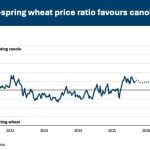CLAYTON, Ont. – It is a safe bet that before this year, Don Dodds had not spent a lot of time thinking about the IQ of the maple trees that dominate the 35-acre sugar bush he operates west of Ottawa.
In the aftermath of the January ice storm, which devastated large areas of the maple sugar industry in eastern Ontario and western Quebec, he is reconsidering how smart those trees are.
This spring, they seem to have out-foxed the humans who try to make a living from them.
Read Also

Farmers urged to be grain-safe this fall
Working around grain bins comes with risk, from farmers falling to drowning in grain: Experts have five tips to help avoid grain-related accidents this harvest.
“Somehow, these trees are very clever,” Dodds said. “They know they are fighting for their survival. It’s like they decided what strategy to use.”
As he spoke, the bush outside his sugar shack 60 kilometres west of Ottawa still showed scars from those awful five days in January when freezing rain fell, the power went out for millions of people and the weight of ice snapped tens of thousands of trees in two.
Limbs litter the ground despite weeks of clean-up. Maple trees towered toward the sky as the afternoon sun glinted off the wounds of the storm – exposed scars where limbs once grew.
“I figure a good 30 percent of my bush was destroyed or damaged,” said Dodds.
Worse than expected
But when maple season rolled around in March and April, the damage turned out to be much greater. Trees traumatized by the storm refused to give sap or kept offerings to a minimum.
The 60-year-old farmer said it was as though they had a mind of their own. Sap collection and maple syrup production on his farm were down by 80 percent, not 30 percent.
“I really can’t explain why, but it’s like the trees knew they needed the sugar to regain strength and kept it,” he said. “Government officials told us to tap this year. The trees knew better.”
Dodds figures the trees protected themselves in a couple of ways.
Normally when a branch breaks off or a hole is cut into a maple tree, it bleeds sap in the spring as temperatures rise and the sugary liquid migrates from the roots up the tree trunk to feed the buds.
This year, Dodds noticed that sap was not oozing from wounds created by the storm. Likewise, when holes were bored for sap collection, little came.
“I think they knew enough to stop the sap from flowing to areas where they had been hurt,” he said.
Even when sap did flow, the sugar content was much lower than usual.
“They really gave as little sugar as they had to,” he said. “They are saving it for the struggle to restore themselves. It is tough for us farmers this year but it should make the trees stronger in the future. These trees really are fighting for their lives and they know what they’re doing. I’ve never seen anything like it.”














